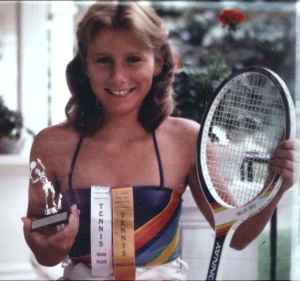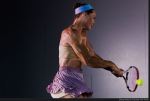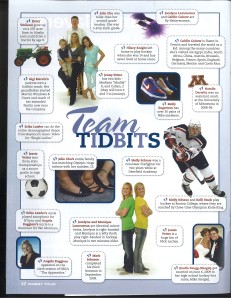
Me with Steve "Wilk" Wilkinson
Last night I attended a tribute to my mentor, friend and tennis coach, Steve Wilkinson. I’ve written about Wilk in previous blogs recounting his accomplishments and 3 Crown Philosophy. I was honored to be able to say a few words about Wilk on behalf of the Gustavus women’s tennis program. I’m sharing those words with you in this blog. There are not many opportunities in life to be in a room with so many people who are such an important part of your life. I was surrounded by many of my tennis mentors and closest friends–friends I made through sport. As I sat there and listened to the words and song of others, I felt truly blessed and even more committed to pursuing my life’s work–making a difference in the lives of others, especially girls and women, through sport.
A Tribute to Steve “Wilk” Wilkinson
December 12, 2009, Nicole M. LaVoi
Good evening. I was invited to say a few words on behalf of the women’s tennis team, an opportunity for which I am grateful, humbled and honored. In preparation for tonight I solicited stories and thoughts from my teammates about how Wilk influenced their lives, so I’ll be speaking from their perspectives, as well as my own.
In reminiscing and in reading their comments, perhaps it is not astonishing the similarities between the lessons we have learned from Wilk, both on and off the court, and how we have integrated those teachings into our adult lives. I would guess much of what I say tonight will resonate with many of you.
Although Wilk was not by title my official coach or the coach of the women’s team—many of us saw him as our coach. He was responsible for my recruiting class in the interim between Dave Pettengill and Scott Novak. Some might argue that Wilk played a large part in crafting the only national championship team of the women’s program—as the senior leadership of that team were all recruited by Wilk. I clearly remember the day during my senior year, I was intent on attending St. Ben’s, when Wilk called and invited me down to visit Gustavus just to “check it out.” Truth be told, I agreed because I could get out of a day of school! Little did I know that call would shape the trajectory of the rest of my life.
It has been a very rewarding experience to think about Wilk’s influence on my own life and to discuss it with teammates. We are not given many moments, nor do we make the time, to reflect in meaningful ways on the people and events we hold so dear. I know that I would not be the person I am today, nor be striving to make a difference in the lives of children, their families and communities through sport, if it weren’t for Wilk.
Wilk has the ability to see the best and the full potential in all people. I would like to think that someday I might become the woman that Wilk saw within the immature, win at all cost, feisty competitive 18 year old whom he was patiently trying to teach how to volley on a cold April day in St. Cloud over 20 years ago. One of my most vivid memories of Wilk was a 10 second exchange my freshman year. We were loading into the tennis van for an away match, and I was carrying a pillow with a pillow case that said “Love means nothing to a tennis player.”
For me it represented annihilating an opponent 6-0, 6-0, something at that time I took great pleasure in. Wilk saw it had that disappointed look on his face…you all know that look…and said, “I wish you wouldn’t ever use that again or bring it on tennis trips”. Of course at the time, it made me want to bring it all the more. That exchange always bothered me but it wasn’t until years later that I finally got it…love means everything to not only a tennis player, but human beings. I’m sure many of us, much later have finally “got” the lessons Wilk was so patiently trying to teach us in our youth.
Wilk is grace personified. Mary Sutherland Ryerse shared that a former pastor defined grace as “undeserved kindness”… which Wilk has consistently shown and modeled for us all. My teammates all offered examples of Wilk consistently going out of his way to help, teach, offer support or listen…win or lose, whether you were sportsmanly or not, were in the starting line up or not, got an “A” or failed a class, or if you got the job or not.
Linnea Carlson shared a story I think is an exemplar: She writes, “Our senior year we had finally beat Kenyon in the Midwest Regional final, 5-4, which was expected. When Kendall Larson and I ran into Wilk at the bubble the next day and told him the news, he got a huge grin on his face and hugged us both…twice. When I retold this story to a member of the men’s team, the player said, “If you had lost, he would have hugged you three times.”
Certainly our days with Gustavus Tennis were filled with goodness, great memories, gratitude, giving of self, giving full effort, goals with a focus on what can be controlled, and gifts of friendship and community….and of course, much grace. I know in my own life a day does not go by without the Serenity Prayer—which I learned from Wilk. Whatever situation I’m in, the Serenity Prayer always applies. I joke with my students that all you need to know about the entire field of sport psychology can be summarized by the Serenity Prayer.
Wilk, you taught me that having a positive attitude and seeing the glass as always half full is not only a choice, but a skill that can be learned. Your unwavering commitment to doing the right thing for the right reason and keeping a positive outlook, even in the most difficult of circumstances, has shaped our character in a world that rewards achievement at the expense of others, short cuts, and instant gratification. I suppose this is why when Wilk asks you to do something, and we all end of saying “yes”…it is because we know it’s the right thing to do!
John Gardner, an American activist, reformer, educator and leader…a man much like Wilk, said “There are men and women who make the world better just by being the kind of people they are” and Wilk you are certainly one of those people. You have taught us that is it us alone who can put the unique ingredients of our lives together in a way that leads to dignity, integrity and meaning…and more importantly if we accomplish this feat, then the particular balance of success or failure is of less account.
Wilk, your impact surely echoes, and spreads exponentially in immeasurable ways. To give a visual (like this rock engraved with the word Serenity which I keep in my office next to my computer) I would describe you as a rock, our rock… cast into a calm lake and your impact as the concentric circles that emanate from your core and reverberate infinitely outward to places unknown. It is my wish, and the wish of many of us from the women’s team, that for you this celebration gives you at least a glimpse of what you have meant, and will continue to mean to so many, myself included. Thank you.













